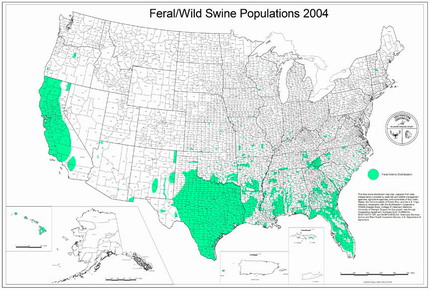Christopher Columbus first introduced members of the family Suidae into North America in 1493 in the West Indies. The first documented introduction of hogs into the United States was in Florida by de Soto in 1593. More introductions followed in Georgia and the Carolinas, which established free-ranging populations in the Southeast. Free-ranging practices continued until they finally became illegal in the mid-twentieth century.

Populations of unclaimed, wild hogs increased and spread throughout the Southeast. Domestic hogs were released in California in 1769 and free-ranging practices there also resulted in a feral hog population. European wild boar were released at Hooper Bald, North Carolina, in 1912, and from there introduced to California in 1925.
Wild pigs (feral hogs) are found throughout the southeastern United States from Texas east to Florida and north to Virginia; and in California, Hawaii, Puerto Rico, and the Virgin Islands. The local introduction of these animals for hunting purposes occurred in North Carolina, Tennessee, Texas, Louisiana, and California. The National Park Service reports feral hogs in 13 National Park Service areas. They occur in many state parks as well (Mayer and Brisbin 1991). Feral hogs are also found in Hawaii, Australia, New Zealand, and several other South Pacific Islands.